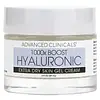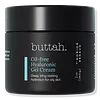What's inside
What's inside
 Key Ingredients
Key Ingredients

 Benefits
Benefits

 Concerns
Concerns

 Ingredients Side-by-side
Ingredients Side-by-side

Water
Skin ConditioningPropanediol
SolventDimethicone
EmollientGlycerin
HumectantPyrus Malus Fruit Extract
Skin ConditioningAmmonium Acryloyldimethyltaurate/Vp Copolymer
Sodium Hyaluronate
HumectantAloe Barbadensis Leaf Juice
Skin ConditioningDipotassium Glycyrrhizate
HumectantButylene Glycol
HumectantCaulerpa Lentillifera Extract
Oryza Sativa Bran Extract
Skin ConditioningRosmarinus Officinalis Leaf Extract
AntimicrobialHelianthus Annuus Extract
EmollientCymbopogon Martini Oil
MaskingCyanocobalamin
Skin ConditioningHydroxyethylcellulose
Emulsion StabilisingSea Salt
AbrasiveCarrageenan
Vaccinium Angustifolium Fruit Extract
Skin ProtectingAscorbic Acid
AntioxidantPolysorbate 20
EmulsifyingRosa Centifolia Flower Extract
AstringentPhenoxyethanol
PreservativeTocopherol
AntioxidantMaltodextrin
AbsorbentTetrasodium Glutamate Diacetate
Caprylyl Glycol
EmollientEthylhexylglycerin
Skin ConditioningSodium Hydroxide
BufferingHexylene Glycol
EmulsifyingCitric Acid
BufferingWater, Propanediol, Dimethicone, Glycerin, Pyrus Malus Fruit Extract, Ammonium Acryloyldimethyltaurate/Vp Copolymer, Sodium Hyaluronate, Aloe Barbadensis Leaf Juice, Dipotassium Glycyrrhizate, Butylene Glycol, Caulerpa Lentillifera Extract, Oryza Sativa Bran Extract, Rosmarinus Officinalis Leaf Extract, Helianthus Annuus Extract, Cymbopogon Martini Oil, Cyanocobalamin, Hydroxyethylcellulose, Sea Salt, Carrageenan, Vaccinium Angustifolium Fruit Extract, Ascorbic Acid, Polysorbate 20, Rosa Centifolia Flower Extract, Phenoxyethanol, Tocopherol, Maltodextrin, Tetrasodium Glutamate Diacetate, Caprylyl Glycol, Ethylhexylglycerin, Sodium Hydroxide, Hexylene Glycol, Citric Acid
Water
Skin ConditioningAloe Barbadensis Leaf Juice
Skin ConditioningCyclopentasiloxane
EmollientDimethiconol
EmollientSodium Acrylate/Sodium Acryloyldimethyl Taurate Copolymer
Emulsion StabilisingPropanediol
SolventPropylene Glycol
HumectantCetyl Stearate
EmollientIsostearyl Isostearate
EmollientCetyl Alcohol
EmollientPotassium Cetyl Phosphate
EmulsifyingStearic Acid
CleansingButylene Glycol
HumectantHexylene Glycol
EmulsifyingPolysorbate 20
EmulsifyingGlycerin
HumectantPentylene Glycol
Skin ConditioningSodium Hyaluronate
HumectantAvena Sativa Kernel Meal
AbrasiveNiacinamide
SmoothingAlteromonas Ferment Filtrate
HumectantPhenoxyethanol
PreservativeEthylhexylglycerin
Skin ConditioningXylitylglucoside
HumectantAnhydroxylitol
HumectantXylitol
HumectantCitric Acid
BufferingLactic Acid
BufferingMalic Acid
BufferingGluconic Acid
Ascorbic Acid
AntioxidantGlycolic Acid
BufferingSalicylic Acid
MaskingTartaric Acid
BufferingPanthenol
Skin ConditioningLeuconostoc/Radish Root Ferment Filtrate
AntimicrobialAllantoin
Skin ConditioningTetrahexyldecyl Ascorbate
AntioxidantTocopheryl Acetate
AntioxidantVitis Vinifera Seed Extract
AntimicrobialAlgae Extract
EmollientDisodium EDTA
Water, Aloe Barbadensis Leaf Juice, Cyclopentasiloxane, Dimethiconol, Sodium Acrylate/Sodium Acryloyldimethyl Taurate Copolymer, Propanediol, Propylene Glycol, Cetyl Stearate, Isostearyl Isostearate, Cetyl Alcohol, Potassium Cetyl Phosphate, Stearic Acid, Butylene Glycol, Hexylene Glycol, Polysorbate 20, Glycerin, Pentylene Glycol, Sodium Hyaluronate, Avena Sativa Kernel Meal, Niacinamide, Alteromonas Ferment Filtrate, Phenoxyethanol, Ethylhexylglycerin, Xylitylglucoside, Anhydroxylitol, Xylitol, Citric Acid, Lactic Acid, Malic Acid, Gluconic Acid, Ascorbic Acid, Glycolic Acid, Salicylic Acid, Tartaric Acid, Panthenol, Leuconostoc/Radish Root Ferment Filtrate, Allantoin, Tetrahexyldecyl Ascorbate, Tocopheryl Acetate, Vitis Vinifera Seed Extract, Algae Extract, Disodium EDTA
Ingredients Explained
These ingredients are found in both products.
Ingredients higher up in an ingredient list are typically present in a larger amount.
Aloe Barbadensis Leaf Juice comes from leaves of the aloe plant. Aloe Barbadensis Leaf Juice is best known for helping to soothe sunburns. It is also anti-inflammatory, moisturizing, antiseptic, and can help heal wounds.
Aloe is packed with good stuff including Vitamins A, C, and E. These vitamins are antioxidants, which help fight free-radicals and the damage they may cause. Free-radicals are molecules that may damage your skin cells, such as pollution.
Aloe Barbadensis Leaf Juice also contains sugars. These sugars come in the form of monosaccharides and polysaccharides, folic acid, and choline. These sugars are able to help bind moisture to skin.
It also contains minerals such as calcium, 12 anthraquinones, fatty acids, amino acids, and Vitamin B12.
Learn more about Aloe Barbadensis Leaf JuiceAscorbic Acid is is pure Vitamin C. This form makes up the largest amount of vitamin C found naturally in our skin.
Not only is vitamin C great for your overall health and immune system, it also has plenty of benefits on your skin.
Vitamin C is best used for brightening skin. It improves dark spots, acne scars, and hyperpigmentation. This is because it blocks the process of skin darkening when exposed to UV.
Remember: Vitamin C should not replace sunscreen!
Your skin uses vitamin C to build collagen. Collagen is one key component in having a strong skin barrier and plump skin. Vitamin C also plays a role in regulating collagen, thus making it effective in improving wrinkles and fine lines.
Ascorbic acid shows potent antioxidant activity. As an antioxidant, it helps fight free-radicals. Free-radicals are molecules that may damage your skin cells. These antioxidants also protect skin against UV damage.
The best formulations include Vitamin E and/or ferulic acid. These two ingredients help stabilize and provide a boost in the benefits of ascorbic acid. This is because ascorbic acid becomes unstable when exposed to UV and air. In fact, you can tell your ascorbic acid has oxidized when it turns an orange-yellow color.
Ascorbic acid is generally compatible with other ingredients. However, using ascorbic acid with other active ingredients might cause irritation. Two ingredients: copper ions and benzoyl peroxide, will inactivate ascorbic acid completely.
Read more about other types of Vitamin C:
Foods rich with vitamin C include oranges, strawberries, broccoli, bell peppers, and more. When consuming Vitamin C, your skin receives a portion of the nutrients.
Learn more about Ascorbic AcidButylene Glycol (or BG) is used within cosmetic products for a few different reasons:
Overall, Butylene Glycol is a safe and well-rounded ingredient that works well with other ingredients.
Though this ingredient works well with most skin types, some people with sensitive skin may experience a reaction such as allergic rashes, closed comedones, or itchiness.
Learn more about Butylene GlycolCitric Acid is an alpha hydroxy acid (AHA) naturally found in citrus fruits like oranges, lemons, and limes.
Like other AHAs, citric acid can exfoliate skin by breaking down the bonds that hold dead skin cells together. This helps reveal smoother and brighter skin underneath.
However, this exfoliating effect only happens at high concentrations (20%) which can be hard to find in cosmetic products.
Due to this, citric acid is usually included in small amounts as a pH adjuster. This helps keep products slightly more acidic and compatible with skin's natural pH.
In skincare formulas, citric acid can:
While it can provide some skin benefits, research shows lactic acid and glycolic acid are generally more effective and less irritating exfoliants.
Most citric acid used in skincare today is made by fermenting sugars (usually from molasses). This synthetic version is identical to the natural citrus form but easier to stabilize and use in formulations.
Read more about some other popular AHA's here:
Learn more about Citric AcidEthylhexylglycerin (we can't pronounce this either) is commonly used as a preservative and skin softener. It is derived from glyceryl.
You might see Ethylhexylglycerin often paired with other preservatives such as phenoxyethanol. Ethylhexylglycerin has been found to increase the effectiveness of these other preservatives.
Glycerin is already naturally found in your skin. It helps moisturize and protect your skin.
A study from 2016 found glycerin to be more effective as a humectant than AHAs and hyaluronic acid.
As a humectant, it helps the skin stay hydrated by pulling moisture to your skin. The low molecular weight of glycerin allows it to pull moisture into the deeper layers of your skin.
Hydrated skin improves your skin barrier; Your skin barrier helps protect against irritants and bacteria.
Glycerin has also been found to have antimicrobial and antiviral properties. Due to these properties, glycerin is often used in wound and burn treatments.
In cosmetics, glycerin is usually derived from plants such as soybean or palm. However, it can also be sourced from animals, such as tallow or animal fat.
This ingredient is organic, colorless, odorless, and non-toxic.
Glycerin is the name for this ingredient in American English. British English uses Glycerol/Glycerine.
Learn more about GlycerinHexylene Glycol is a surfactant. Glycols are a class of alcohols. Hexylene Glycol is a surfactant and emulsifier.
As a surfactant, Hexylene Glycol helps gather dirt and oil on your skin to be washed away.
As an emulsifier, Hexylene Glycol helps keep water and oil together. This prevents them from separating in a product. Hexylene Glycol also thins out the texture of a product by lessening viscosity.
Hexylene Glycol has a small molecular weight.
Learn more about Hexylene GlycolPhenoxyethanol is a preservative that has germicide, antimicrobial, and aromatic properties. Studies show that phenoxyethanol can prevent microbial growth. By itself, it has a scent that is similar to that of a rose.
It's often used in formulations along with Caprylyl Glycol to preserve the shelf life of products.
Polysorbate 20 is made by combining ethoxylation of sorbitan, ethylene oxide, and lauric acid. It is a mild cleansing agent, surfactant, and emulsifier.
As a surfactant, it helps collect dirt and oils for washing. Emulsifiers prevent oils and water from separating.
Polysorbate 20 also adds scent to a product. Since it is made using sorbitol, it has a sweet scent. Sorbitol can also be found in fruits such as apples and peaches.
The lauric acid used to create Polysorbate 20 is often derived from coconuts.
Polysorbate 20 may not be fungal acne safe.
Learn more about Polysorbate 20Propanediol is an all-star ingredient. It softens, hydrates, and smooths the skin.
It’s often used to:
Propanediol is not likely to cause sensitivity and considered safe to use. It is derived from corn or petroleum with a clear color and no scent.
Learn more about PropanediolSodium Hyaluronate is hyaluronic acid's salt form. It is commonly derived from the sodium salt of hyaluronic acid.
Like hyaluronic acid, it is great at holding water and acts as a humectant. This makes it a great skin hydrating ingredient.
Sodium Hyaluronate is naturally occurring in our bodies and is mostly found in eye fluid and joints.
These are some other common types of Hyaluronic Acid:
Learn more about Sodium HyaluronateWater. It's the most common cosmetic ingredient of all. You'll usually see it at the top of ingredient lists, meaning that it makes up the largest part of the product.
So why is it so popular? Water most often acts as a solvent - this means that it helps dissolve other ingredients into the formulation.
You'll also recognize water as that liquid we all need to stay alive. If you see this, drink a glass of water. Stay hydrated!
Learn more about Water